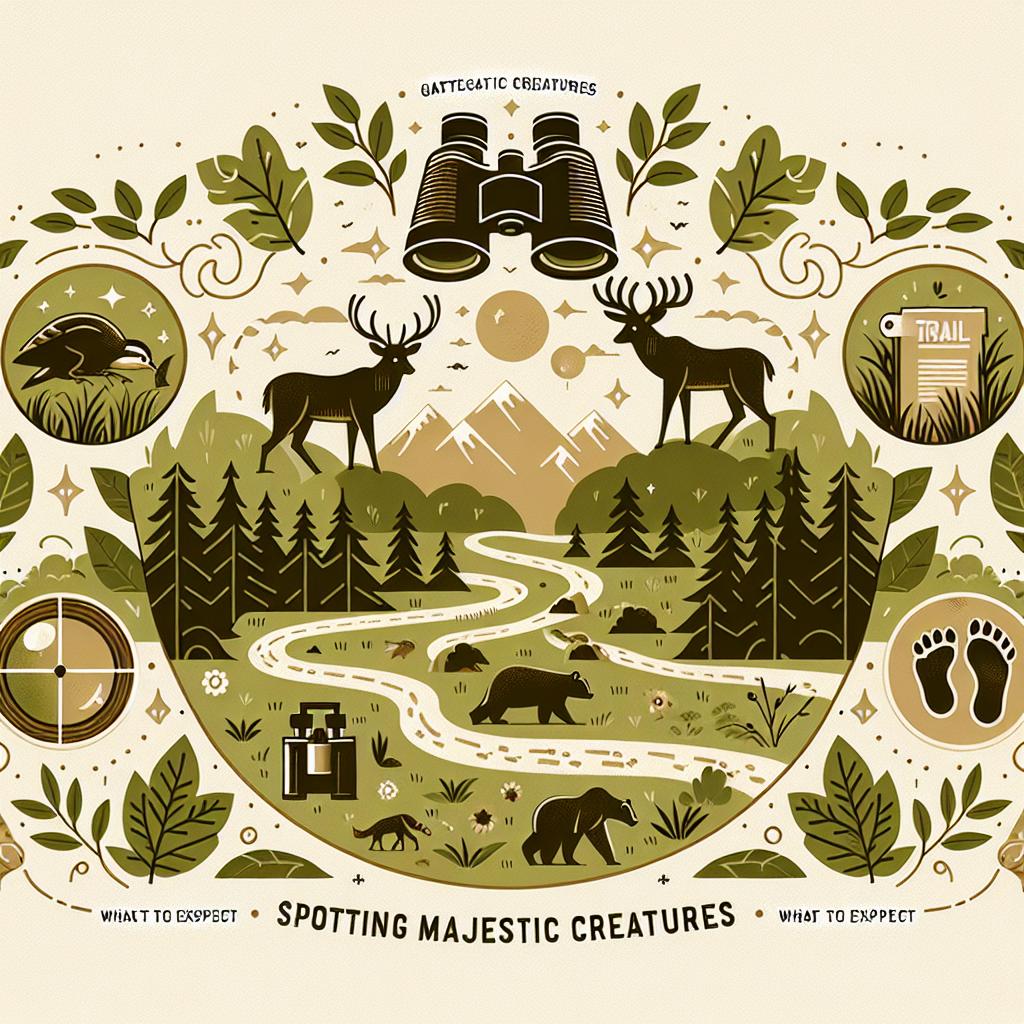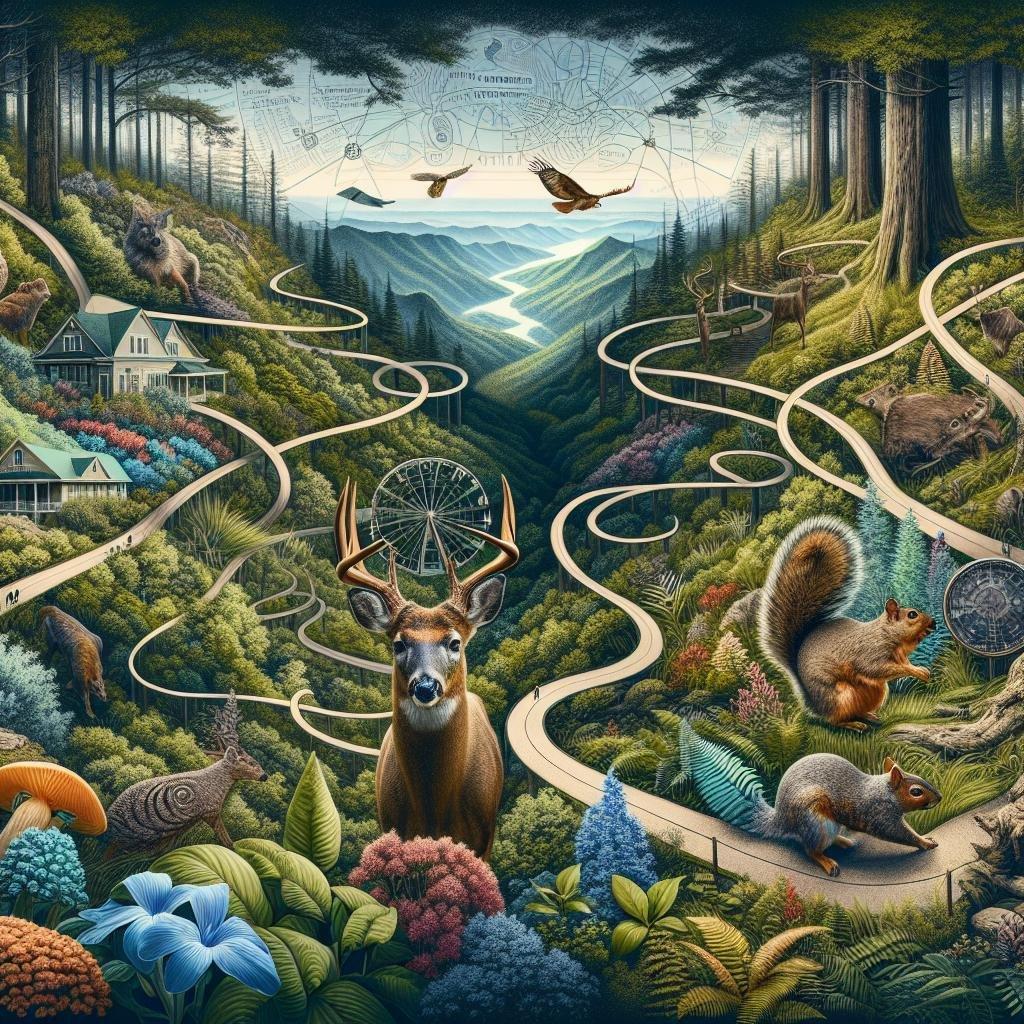Nestled in the flourishing embrace of the Great Smoky Mountains, Gatlinburg stands as a verdant gateway to a world where nature’s wonders unfold at every turn. As hikers meander through the winding trails, the rhythmic crunch of leaves underfoot and the whisper of the mountain breeze set the stage for encounters with the region’s abundant wildlife. In this natural amphitheater, the chorus of birdsong mingles with the rustle of hidden creatures, creating an enchanting backdrop for those willing to explore beyond the beaten path. This article delves into the diverse array of wildlife one might encounter on Gatlinburg’s hiking trails, where each step offers a glimpse into the vibrant ecosystem that thrives amidst the ancient forests and cascading streams. Join us as we embark on a journey through this wilderness, discovering the captivating interplay between hikers and the untamed inhabitants of this Appalachian haven.
Spotting Majestic Creatures: What to Expect on Gatlinburg Trails
Venturing along the enchanting trails of Gatlinburg, you’ll find yourself immersed in a natural sanctuary teeming with wildlife wonders. Keep your eyes peeled for the elegant movements of the white-tailed deer, the playful antics of black bears, and the dazzling flutter of numerous butterfly species. Hikers often stumble upon majestic creatures like elk grazing amidst the lush greenery or spot a red fox quietly trotting across the path. The cool trickle of streams lining the trails often serves as a meeting point for various forest residents, including otters and raccoons, offering a sense of tranquility and connection with nature. Amidst the rustling leaves and symphony of bird calls, finding such moments can be both a surprise and a delight for those carrying a sense of wonder.
To increase your chances of encountering these remarkable wildlife species, it’s helpful to venture into specific trails known for their rich biodiversity. Some recommended trails include:
- Laurel Falls Trail: Renowned for its scenic waterfall and frequent bear sightings.
- Cades Cove Loop Road: Ideal for spotting deer, turkeys, and coyotes.
- Clingmans Dome: Offers opportunities to see a variety of bird species.
- Grotto Falls: A haven for salamanders and rare plant species.
| Trail Name | Wildlife Highlight | Best Time to Visit |
|---|---|---|
| Laurel Falls Trail | Bears & Waterfalls | Spring & Fall |
| Cades Cove Loop Road | Deer & Coyotes | Early Morning |
| Clingmans Dome | Bird Watching | Summer |

Understanding Wildlife Behavior: Safety Tips for Hikers
Hiking through the enchanting trails of Gatlinburg offers an unparalleled opportunity to witness the beauty of wildlife in their natural habitat. But to ensure these encounters are both safe and enjoyable, it’s crucial to understand the behaviors of the animals you might meet. Bears, for instance, are often misunderstood as aggressive, but in reality, they mostly avoid human contact unless provoked. If you come across a bear, calmly walk away while keeping an eye on it, ensuring it’s aware of your presence. Deer are shy creatures; avoid sudden movements or noises that might startle them. Keep a respectful distance, allowing them to roam freely.
To enhance your safety:
- Travel in groups to appear larger and more intimidating to potential wildlife.
- Make noise periodically, signaling your presence to avoid surprising animals.
- Carry a whistle or air horn as a deterrent.
| Wildlife | Behavior | Tip |
|---|---|---|
| Black Bear | Generally avoids humans | Back away slowly |
| Deer | Shy and easily startled | Keep quiet and observe |
| Raccoon | Curious and nocturnal | Secure all food items |
Essential Gear for Wildlife Encounters: What to Pack and Why
When embarking on an adventure through Gatlinburg’s hiking trails, it’s imperative to be prepared with the right gear, ensuring both safety and an enriching experience. Binoculars are a must-have for any wildlife enthusiast. They allow a closer look at distant creatures without disturbing their natural habitat. Investing in a lightweight and powerful set can make spotting elusive wildlife, like black bears and wild turkeys, a more thrilling activity. Similarly, a field guidebook specific to the Smoky Mountains’ fauna can enhance your understanding of the various species you encounter. Always carry a camera or high-quality smartphone, equipped with a zoom function, to capture those memorable wildlife moments.
Safety should never be compromised, which is why a few key items should always be in your pack. A first-aid kit tailored for wilderness settings is critical, providing peace of mind in the face of minor injuries. Bear spray, though rarely used, serves as an essential precaution for any close encounters with the Great Smoky Mountains’ more formidable inhabitants. Snacks are another vital inclusion, with high-energy options like trail mix or protein bars proving perfect for long treks. Consider packing a whistle for emergency signaling and a headlamp for navigating dusky or low-visibility areas. This gear not only enhances safety but also elevates your overall experience on the trail.
| Item | Purpose |
|---|---|
| Binoculars | View distant wildlife closely |
| Field Guidebook | Identify local wildlife species |
| First-aid Kit | Manage minor injuries |
| Bear Spray | Protection against close encounters |

Respecting Natures Inhabitants: Leave No Trace Principles for Hikers
The beauty of Gatlinburg’s trails is amplified by its diverse wildlife, which calls for hiking etiquette inspired by the Leave No Trace principles. To protect these inhabitants and ensure that future trekkers can enjoy the same experiences, hikers should consider a few essential guidelines. Start by sticking to marked paths, as straying off-trail can damage habitat zones and disturb wildlife. Moreover, avoid feeding animals; although tempting, it disrupts their natural foraging habits and can lead to dangerous human-wildlife encounters. Always carry out what you bring in, as litter can harm animals and their environments. Keep a respectful distance from all animals—large and small—to minimize stress to the creatures and for your own safety.
Opportunities to witness Gatlinburg’s rich biodiversity abound, and knowing how to engage responsibly enhances both your experience and the natural balance. In areas where animal activity is frequent, maintaining a soft voice and avoiding sudden movements can prevent unnecessary excitement or fear. Consider hiking with binoculars to observe from afar and bring a wildlife identification guide to enhance your understanding of the creatures you may encounter. Remember, these pathways wind through the home of many species; appreciation and respect keep the trail magic alive for all visitors. For a quick reference, here is a table of simple actions compared to their impact on wildlife:
| Action | Impact |
|---|---|
| Stay on Path | Minimizes habitat disturbance |
| Do Not Feed | Maintains natural foraging habits |
| Carry Out Trash | Prevents pollution and animal injury |
| Keep Distance | Reduces stress and promotes safety |
Q&A
Q&A: Navigating Wildlife Encounters on Gatlinburg Hiking Trails
Q1: What types of wildlife might I encounter on hiking trails in Gatlinburg?
A1: Hiking trails in Gatlinburg are a gateway to encountering an array of wildlife. You might spot white-tailed deer gracefully moving through the underbrush, or hear the melodic songs of warblers and thrushes. Black bears, though elusive, are a possibility, as are synchronized flashes of fireflies in the twilight. From curious raccoons to timid turkeys, the rich biodiversity adds an element of surprise to any hike.
Q2: How should I react if I encounter a black bear on the trail?
A2: Encountering a black bear can be thrilling yet daunting. The key is to remain calm. Avoid running away, as this may trigger a chase instinct. Instead, gradually increase the distance between you and the bear. Speak in a calm, assertive voice and make yourself appear larger by waving your arms or holding your backpack above your head. Typically, black bears are shy and uninterested in human presence, so they will likely saunter off if they don’t feel threatened.
Q3: What steps can I take to minimize wildlife encounters while hiking?
A3: Minimizing encounters begins with preparation. Traveling in groups tends to reduce surprise interactions, as collective noise alerts wildlife to your presence. Stick to marked trails, keeping aware of your surroundings. Proper food storage is crucial—use bear-proof containers and never leave food scraps behind. This not only reduces encounters but also protects the animals by preventing them from becoming reliant on human food sources.
Q4: Is it safe to take pictures of the animals I see on the trail?
A4: Photography is a fantastic way to document your journey, but prioritize safety. Maintain a safe distance, using zoom features rather than physical approach to capture images. Avoid startling wildlife with sudden movements or sounds. Remember, your experience should have minimal impact on natural behaviors, so exercise patience to observe animals in their undisturbed state.
Q5: Are there specific regulations or guidelines I should be aware of before hiking in this area?
A5: Yes, some general guidelines ensure both your safety and that of the wildlife. Adhere to Leave No Trace principles, carrying out what you carry in. Also, familiarize yourself with the park’s rules regarding wildlife interactions and abide by closures or restrictions aimed at protecting both hikers and animals. Always check for any trail advisories or warnings before setting out.
Q6: What should I do if I come across injured or distressed wildlife while hiking?
A6: If you encounter wildlife that appears injured or distressed, resist the urge to intervene directly, as this could be dangerous due to the unpredictable nature of wild animals. Instead, note your exact location and report the situation to park rangers. They are trained to assist and rehabilitate wildlife when necessary, ensuring the safety and well-being of both you and the animal involved.
In Summary
As the sun dips behind the majestic peaks of the Smokies, painting the sky with hues of amber and lavender, the trails of Gatlinburg become quiet once more. Each path, with its stories of wildlife encounters, remains a tapestry woven with whispers of rustling leaves and the distant call of woodland creatures. The wonders unveiled along these trails remind us of the delicate dance between humans and nature—a dance that requires respect, understanding, and awe. Whether it’s the sudden hush as a deer crosses your path or the thrill of spotting a black bear from afar, each encounter enriches our journey and deepens our connection to the natural world. As you lace up your boots and venture out, remember to tread lightly, for the true magic of these trails lies in a world that thrives best with harmony as its guide.

